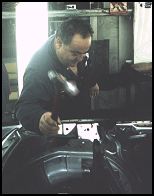 |
|
|
|
The
Classroom and Hands-On Training
|
||
 |
|
|
|
The
Classroom and Hands-On Training
|
||
Safe Operating Procedure: With the torch connected to the oxygen and acetylene source, and the corresponding gauges properly set , the torch is now ready to be ignited. The torch body gas gas flow regulating valves for both the oxygen and acetylene gases. When not in use, their valves should be closed. To ignite the torch, turn each valve 1/8 turn to the open position and spark the torch nozzle by using a flint and steel striker. The torch flame can be adjusted to provide varying degrees of temperature. Weak oxygen pressure, combined with weak acetylene pressure, will result in a low temperature flame. Strong oxygen pressure, combined with strong acetylene pressure, will result in high temperature flame. Both the oxygen and acetylene valves can be adjusted independently to achieve the desired temperatures and lengths of torch flames.  Brazing
Repair Procedure:
|
Best viewed at 800 x 600
Resolution
|